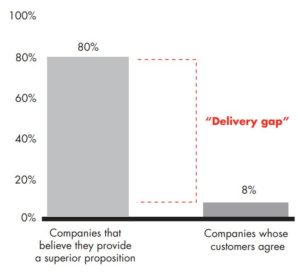
More companies are beginning to value customer experience as part of the priorities they must focus on if they want to stay relevant in a highly competitive and ever-evolving market. With their strong desire to answer customer demands, they launch campaigns they believe adequately satisfy consumer needs. Sadly, a study from Bain & Company shows otherwise.
Fig. 1. Delivery gap
(Source: Bain & Company)
As the figure states, there is a delivery gap on what companies think they’re providing compared to what consumers feel brands deliver. This disparity is often caused by a shallow understanding of customer experience.
To make sure you don’t succumb to this delivery gap, here are 6 customer experience strategy best practices for your organization to implement.
1. Create a culture that values customer experience.
Before you try to improve your brand image, contemplate how you can become a customer-centric business from the inside. The foundation of great customer service should start within the organization. It should be ingrained in the values you practice and integrated with the objective you’re trying to attain.
It’s discordant to be strict with your employees to value each customer they encounter when you can’t do the same. If you want them to be committed to delivering the best customer experience possible, management needs to show the same dedication in retaining each of the brand’s customers.
The key to a successful customer experience strategy is focusing on what customers want rather than what your business thinks they want. For this to happen, there should be a shift from a traditional business structure to a customer-centric organization. This requires a holistic approach involving everyone’s participation.
It’s not uncommon to see the higher-ups deprioritizing or even neglecting customer experience in their agendas. Why? Typically, it’s believed that it is the job of the customer support team to handle most matters, but this line of reasoning often shows a limited understanding of customer experience strategy.
Customer experience affects the whole organization, so it should become a concern for everybody on the team. Its value must be consistently observed from both the highest tier of the management and the frontline employees, as well as everyone in between.
2. Know your customers on a personal level.
You won’t be able to make good use of customer experience strategy best practices if you don’t know your users well.
Customers nowadays look for personalized interactions. With the amount of information they provide and the availability of technology to process big data, there are no excuses to not offer a personal interaction with each customer.
According to an Accenture study, personalization is one of the major business models shaping the future of digital commerce. Consumers are 48% more likely to try curated suggestions carefully selected by experts based on customers’ previous purchases. This trend has the potential to tap an additional $2.95 trillion from the market.
Fig. 2. Customer expectations within an hour after providing brands personal information
(Source: Segment)
Segment also made an in-depth study on personalization commerce and found that 71% of consumers display frustration when they receive impersonal experiences. Customers also expect fast responses from brands the moment they provide personal information, as displayed in the figure above.
Mystery shopping programs can help you better know and understand your customers and identify areas where you can improve your relationship with them. Start by developing personas using the information you’ve gathered about your customers. From there, analyze each customer touchpoint to understand how they want to be served.
3. Consider customer service as part of your marketing strategy.
Customer support is an essential part of any business endeavor. Some see this as a liability that organizations are forced to accept so they can provide proper customer support. But what if you can turn this department into a profitable marketing instrument of your customer experience strategy?
By incorporating ways for customer service representatives to discuss new products, offer discounts, introduce upcoming releases and request feedback and reviews in a natural and subtle manner, you turn a simple support service into a marketing powerhouse.
As part of your customer experience strategy best practices, invest in training and empowering your staff to find alternative solutions for your customers. Teach them to quickly resolve problems and reduce escalations which can negatively impact brand image. Eventually, you’ll notice how effective they’ll be in increasing customer retention and adding a good percentage to your profits. Their value to the company will ultimately exceed the amount you invest in them.
There is so much to learn from employees who interact with customers every day. You can attain details on their first-hand experience responding to common customer issues and gain insight on how these are resolved on the ground level. Needless to say, your customer support team should be integral to the planning phase of any customer experience strategy.
4. Bring in people who love to talk to customers.
Many organizations still give little emphasis to customer service, thinking it’s an easy job to accomplish. Contrary to their typical assumptions, the job of a customer service representative is stressful. They are often customers’ first point of contact and bear the brunt of the anger, dissatisfaction or irritation customers express.
Remember that your employees are the backbone of the company. Customer service representatives play an important role in maintaining your brand image, which is why you should focus hiring and taking care of professionals that communicate well.
5. Choose support channels.
Part of the customer experience strategy is identifying which communication channel works best for your customers. It’s nice to have a multi-channel approach where you offer a number of ways people can contact your business. While it might seem that the more options you provide, the more convenient it will be for your customer, this may not necessarily be true. Handling a number of communication channels can work as a double-edged sword if not managed carefully.
Be cautious to not spread limited resources too thin and sacrifice the quality of customer service experience you deliver in exchange for more methods of communication.
Having an FAQ section on your official website is a must. Consumers like resolving problems on their own and ask for help as a second option. Offer a chat feature and a phone number to show that your lines are open whenever needed.
At the end of the day, you need to focus on the channels used by the majority of your customers. A multi-channel approach is only effective if you can provide the same quality of service across each medium.
6. Regularly measure your performance.
What Peter Drucker – one of the greatest management minds of all time – said remains true to this day: “If you can’t measure it, you can’t improve it.”
Regardless of the form of customer experience strategy you implement, it should always be quantifiable so you can determine its efficiency and make adjustments for improvement. Analyze whether your objectives are being met. Gain feedback from customers and act on their valuable insights.
Learn to better assess your customer experience strategy best practices with a professional mystery shopping company like SeeLevel HX. We can provide you with actionable reports summarizing the objective observations and qualitative insights from guided mystery shoppers.
Conclusion
Customer experience is an important aspect to any business. Best practices should be observed consistently to ensure brand expectations are met and consumers are served professionally. Putting customers at the center of business operations can increase brand loyalty and profitability. Send us a message and let’s discuss how we can support your customer experience delivery.



